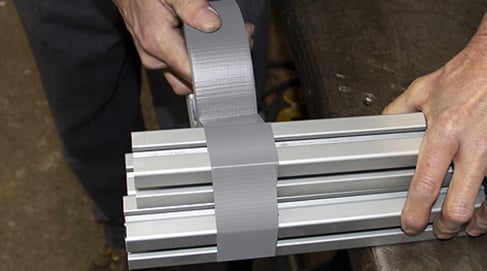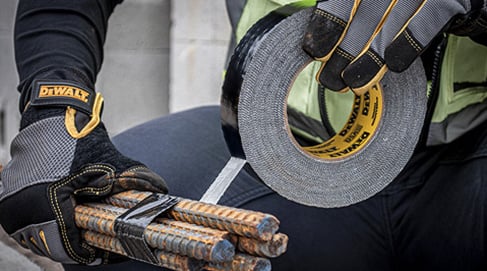MATCH THE TAPE TO THE TASK:
How to Choose the
Right Duct Tape
The Importance of Choosing the Right Duct Tape
Imagine working on a critical project, only to realize that the tape you’re using isn’t adhering properly. The result? Costly delays and rework. Or picture a scenario where a color-coded system is required for organization and safety, but the available tape options don’t meet the necessary color or durability standards. These situations highlight the importance of selecting the right duct tape for the task.
In this guide, we’ll help you navigate the different varieties of duct tape to avoid such frustrations and ensure you’re using the best option for your needs.
A Brief History of Duct Tape
Duct tape’s history is rooted in World War II, when the U.S. military needed a waterproof, durable adhesive to keep moisture out of ammunition cases. A U.S. manufacturer developed a strong, rubber-based adhesive applied to a cloth backing, and soldiers quickly realized its versatility. Beyond ammunition, duct tape became a
go-to solution for battlefield repairs.
After the war, the tape’s utility expanded to civilian use. By the 1950s, it became widely used in various industries. As demand grew, manufacturers innovated, creating the modern silver-colored tape we often associate with heavy-duty work today. Today’s
duct tape has evolved into a highly diverse product, with options ranging from the industrial-strength AC778 to the aesthetically pleasing AC49.

Key Terms to Know
Understanding these key terms will help you select the right duct tape variety for your specific application:
- Adhesive: The sticky substance on one side of the tape that allows it to bond to surfaces. Industrial-grade adhesives can withstand extreme temperatures, moisture, and heavy loads, making them suitable for demanding tasks.
- Polyethylene Coating: This coating provides waterproofing, durability, and enhanced strength. Duct tapes with thicker polyethylene coatings are ideal for outdoor or high-moisture environments.
- Tensile Strength: This measures how much stress the tape can endure before breaking. Higher tensile strength is crucial for industrial applications, such as bundling or securing heavy objects.
- Backing Reinforcement: The tape's backing material adds strength and durability, ensuring that it can withstand heavy-duty applications without tearing or breaking easily
Download our eBook Today!
Our guide is an invaluable resource for your team. It helps address common questions and overcome objections when selecting the perfect duct tape for various tasks. Keep this eBook handy to ensure you always make informed decisions.
INDUSTRIAL
AC778: Industrial-Grade,
Acrylic Pressure-Sensitive Adhesive
Known for its robust sealing and protection capabilities, the AC778 is ideal for heavy-duty applications like bundling materials and protecting surfaces. Its pressure-sensitive adhesive ensures a long-lasting bond on a wide range of surfaces.
Iron Grip (AC617):
High Adhesion and Conformability
Available in black and white, Iron Grip AC617 offers superior adhesion to rough or uneven surfaces. Its rubber-based adhesive sticks aggressively, while its flexibility allows it to conform to irregular shapes—making it perfect for challenging environments.
AC36 Duct Tape:
High-Performance Polyethylene Coated Cloth
With its chrome finish, AC49 is designed for both appearance and performance. It offers excellent adhesion and conformability in a variety of applications where aesthetics are important.
AC20:
Versatility with a Splash of Color
Available in a variety of colors, AC20 is ideal for color-coding, organizing cables, marking areas, or adding a decorative touch. They offer the same durability and reliability as traditional duct tapes, with added visual benefits.
AC49:
Metalized Duct Tape
The general contractor’s duct tape of choice! An 11 mil polyethylene-coated cloth tape with an aggressive natural rubber adhesive system designed to provide exceptional shear strength. For demanding applications such as abatement, weatherproofing, extermination, and all general maintenance needs.

CONSUMER
Utility Grade Duct:
6 mil polyester (PET) cloth / polyethylene (PE) film with an aggressive natural rubber pressure sensitive adhesive combine to provide a quality utility product. Conformable to irregular surfaces. For packing, wrapping & sealing, binding & bundling, and general maintenance.
FIX IT DUCTape®:
Designed for both indoor and outdoor use, FIX IT Ductape offers strong adhesion and excellent durability. With a thickness of 7 mils, its versatile nature makes it perfect for repairs, patching, and sealing, ensuring a long-lasting hold on smooth, rough and irregular surfaces.
JOBSITE DUCTape™:
A 9 mil all-purpose duct tape for general maintenance applications such as wrapping and sealing, weather proofing, binding and bundling. Available in 9 colors.
XHD DUCTape™:
10 mil polyester (PET)/polyethylene (PE) coated cloth tape with an aggressive pressure sensitive natural rubber adhesive.
DEWALT Ultra-Tough
Duct Tape:
A heavy-duty, 17 mil duct tape with waterproof backing and strong adhesion for contractor-grade applications. Made for an all-weather performance, with an ultra-strong adhesive.

Does Duct Tape Thickness Matter?
When it comes to duct tape, thickness is indeed a crucial factor that can significantly impact its performance and suitability for various applications. Measured in mils (one-thousandth of an inch), duct tape thickness can determine its strength, durability, and overall effectiveness in a given task.
 The Advantages of Thicker Duct Tape
The Advantages of Thicker Duct Tape
Thicker duct tapes, which typically have a higher mil rating, offer several advantages, particularly in heavy-duty and industrial applications. Their increased thickness provides greater tensile strength, meaning they can withstand more stress and pressure before breaking. This makes thicker duct tapes ideal for bundling heavy materials, securing large objects, and handling high-impact tasks where durability is paramount. Additionally, thicker duct tapes offer superior resistance to wear and tear, holding up better against abrasions, moisture, and harsh environmental conditions, such as UV exposure or extreme temperatures. This makes them the preferred choice for outdoor use or long-term applications.
Thicker tapes also tend to have stronger adhesives, ensuring they stay in place for extended periods without peeling or losing adhesion. These properties make thick duct tapes well-suited for applications such as sealing, surface protection, and reinforcement in rugged environments where reliability is key.
The Benefits of Thinner Duct Tape
On the other hand, thinner duct tapes have their own set of advantages, particularly when flexibility and ease of use are more important than strength. Thinner tapes are typically more flexible and conformable, making them ideal for wrapping around cables, irregular surfaces, or lightweight packages. Their thin profile allows them to fit into tight spaces more easily. For tasks that require precision and a more delicate touch—such as crafting, temporary repairs, or color-coding—thinner duct tapes are often a better choice.
In addition, thinner duct tapes are easier to tear by hand, which can be a time-saving feature in situations that require quick fixes or frequent application adjustments.
Choosing the Right Thickness for Your Application
Ultimately, the right duct tape thickness depends on the specific needs of your project. For heavy-duty, long-term, or outdoor applications, a thicker duct tape will provide the strength, durability, and adhesive power necessary to ensure reliable performance. Conversely, for smaller, more delicate tasks that require flexibility and ease of use, a thinner duct tape will offer the versatility and convenience needed for a successful outcome.
By understanding the importance of duct tape thickness, you can make more informed decisions and choose the best tape for your particular application, ensuring that you achieve the results you need without compromise.
Tips for Using Duct Tape
-
 Choose the Right Tape: Select a tape specifically designed for your project. For example, if you're organizing cables or need to mark off specific areas, Colored Duct Tape is perfect for color-coding or organizing tasks. Its durability and visibility make it an ideal choice for labeling in work environments.
Choose the Right Tape: Select a tape specifically designed for your project. For example, if you're organizing cables or need to mark off specific areas, Colored Duct Tape is perfect for color-coding or organizing tasks. Its durability and visibility make it an ideal choice for labeling in work environments. -
Prepare the Surface: Ensure the surface is clean and dry before applying the tape for maximum adhesion.
-
Apply Without Stretching: Stretching the tape during application can weaken the adhesive bond, so apply it smoothly and firmly.
-
Cut Cleanly: Use sharp scissors or a utility knife for a clean edge, preventing fraying and ensuring a professional finish.
Common Mistakes to Avoid
- Using Standard Duct Tape in High-Heat Environments: Always check the tape's heat resistance.
- Assuming All Duct Tapes Are Waterproof: Ensure you select a waterproof option for moisture-heavy applications.
- Neglecting Thickness: Using a tape that is too thin for heavy-duty tasks can lead to failure.
Analyzing Duct Tape Performance
To ensure you’re using high-quality duct tape, test its adhesive strength by applying a small piece to a surface. Assess the tape's tensile strength by pulling on it, and check its flexibility to see how well it conforms to irregular shapes.
Choosing the Right Tape
for Your Needs
Start by examining the tape's adhesive strength and tensile strength, and consider its flexibility for uneven surfaces. IPG offers a comprehensive range of high-quality cloth duct tapes, from utility grade to premium grade, crafted from the finest raw materials to meet the highest industry standards. Shop our line of duct tape today!

